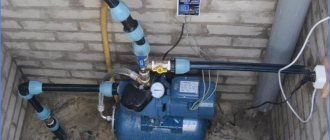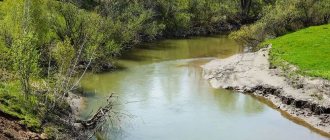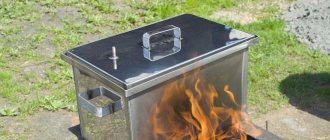Here you will learn:
- Drilling depth
- Types of drilling methods
- Features of manual drilling
- Auger drilling
- Rotary drilling
- Core method
- Hydro drilling
- Drilling stages
- Which technology is used most often?
There are the following methods for drilling water wells: auger, rotary, percussion-rope drilling, core, hydraulic drilling, percussion method. The choice of method depends on the depth of the well.
Kinds
- Artesian.
- On the sand.
- Abyssinian.
- Water intake.
- Pressure.
- Piezometric.
- Drainage.
Artesian
Made for large houses. The depth can reach 100 meters or more. The dacha is equipped with a casing and service pipe. The first has a diameter of 159 or 133 mm. The second is 133 or 117 mm. The diameter of the well is determined based on needs.
Principle. First, the casing becomes clogged. It houses an operational and deep-well pump.
Pros:
- High performance.
- Long service life.
- Stable level.
Minuses:
- High price.
- Long production time, up to 7 days.
- Use of an expensive treatment system due to high mineralization.
- Use of large equipment.
- A package of permits is required.
On the sand
The depth is determined by the level of the aquifer. The water well for sand is located in the second interlayer layer. Liquid accumulates in sandy deposits. Its depth can be a minimum of 15 m and a maximum of 30 m. It is produced mainly by the auger drilling method.
Operating principle. The source diameter is 100 mm. A special filter tube is placed at the bottom. Subsequently, it may become clogged and will have to be drilled again. The liquid is supplied to the top using pumping equipment.
Good to know: with constant use it will last up to 20 years - this is at best.
Pros:
- Minimum investment.
- The simple design allows you to do it yourself.
- Possibility of using small drilling rigs.
- Possibility to drill in any convenient place.
- There is no need to build a complex filtration system.
Minuses:
- Operational life.
- The performance is affected by the water level.
Abyssinian
The Abyssinian water well is a small source that can be made in the territory of a private house, garage or other indoor space. The liquid is extracted from a depth of about 15 meters. Mostly the water is potable and clean. It has a favorable mineral composition.
Operating principle. It is based on an inch pipe. At its lower end there is a special filter and a drilling element – a needle. The pipe is driven into the ground, and a pump is installed on top to create a vacuum.
Pros:
- Made by hand.
- Does not interfere with landscape design.
- There is no need to rent special equipment.
- The pump is remote or located in a caisson above the source itself.
- The work will take about 1 day.
- Silting is excluded.
- Capacity up to 3 cubic meters/hour.
- If necessary, it can be easily dismantled and moved to another location.
Minuses:
- Depth limitation.
- Must be used constantly. Otherwise, you will have to pump, which is a labor-intensive process.
Water intake
It is made in a limestone or sandy aquifer. If it hits limestone, the source will be deep, more than 40 meters. This entails additional costs for installing more casing. Despite this, the quality of the liquid is excellent. It is not subject to any contamination.
Operating principle. Water intake wells must have a design if we are talking about water supply to enterprises. This also applies to a private home. The system consists of one or two lifts. At the first stage, hydraulic equipment is installed, which pumps water.
Well types
Water wells can be divided into three main types, depending on the target aquifer (Figure 2):
- shallow sand;
- deep sand;
- limestone (artesian aquifer).
Figure 2. Location of aquifers
In the Moscow region, the location of aquifers varies in the following intervals:
- first (shallow sand) – 10 – 30 m;
- second (deep sand) – 40 – 90 m;
- the third (limestone) reaches 220 m.
Limestone wells are an aquiferous complex of Paleozoic coal deposits that feeds the Moscow region and is divided into several horizons:
- Serpukhovskaya (Lower Carboniferous);
- Podolsko-Myachkovsky (Middle Carboniferous);
- Kashira (Middle Carboniferous);
- Kasimov layer (upper Carboniferous);
- Gzhel (Upper Carboniferous).
The Moscow region is divided into the following aquifer areas:
- southern - the water level is at a depth of 10 - 70 m, the depth of the wells is from 40 to 120 m;
- southwestern - has a small flow rate, well depth on average 50-70 m;
- the central region is the largest in area, the waters are predominantly carbonate, carbonate-sulfate;
- eastern - the depth of the aquifer is 20 - 50 m, the waters are highly mineralized.
Assessing the state of groundwater in the Moscow region is significantly complicated by the high intensity of their use in a relatively limited area.
Although the population of Moscow is almost 100% supplied with surface water, in the region, on the contrary, most water consumption facilities use groundwater. At the same time, the number of autonomous consumers is growing every year - these are new cottage villages, industrial enterprises and holiday homes.
According to data for 2011, the potential of water resources in the Moscow region is 11.3 million m3/day. The highest operational density of water intake (up to 2 l/s per km2) is located in the central part of the region.
As a result of the high intensity of consumption of groundwater resources, an extensive depression crater has formed in the region, which unevenly covers various aquifers, and its center is located in Moscow.
Device and circuit
The diagram shows water layers. The high water is fed by precipitation and lies at a depth of up to 10 meters. The quality of the water allows it to be used immediately for drinking. A source with interstratal waters is made independently. To obtain better quality water, an artesian well is made.
According to SNiPs and established standards, the source is protected from any kind of pollution. The distance from the septic tank is 15 meters. Cesspools at least 50 m away. More than 100 meters from warehouses and industrial enterprises. The distance from a neighboring source, residential buildings, chicken coops and barns is also taken into account.
Advice: drilling a well for water near trees with a large root system is difficult.
Tips before you start
In order to approach well drilling technology wisely and without disastrous consequences, you should pay attention to several important nuances.
Intensity. With uncontrolled and massive water intake, the so-called suffusion of the soil can begin, as a result of which it sinks quite deep, which is especially deplorable for areas with residential buildings.
Depth. When drilling independently on a plain in Russia, the critical depth is twenty meters. If you want to drill deeper, ask the experts how much such work costs, and you will be pleasantly surprised, since drilling a deep well yourself will cost much more.
Term of use. The period of operation of any well greatly depends on how often and how much water will be taken from it. If you use a sand well rationally, it can last 15 years, but an artesian well will wither within five years if you pump water from it uncontrollably.
How to drill with your own hands at the dacha or in a private house
Perform a number of preparatory steps:
- The selected location should not be the lowest point on the site.
- The ground slope is no more than 35 degrees.
- When using special drilling rigs, it is important to organize a place for access.
- The area on the summer cottage must be at least 4 by 9 m.
Advice: manual drilling of water wells requires less preparation, but when it comes to using special equipment, it is necessary to coordinate all the nuances.
Hydro drilling
It is carried out with a powerful jet of water from a special drilling tool. The advantage of the technology is that it is possible to drill wells in rocky soil.
The jet load is provided by the weight of the rod and drilling equipment. A special solution is poured into the installation, which is then sent to the prepared pit.
The main requirement is the use of a special installation for manual downhole hydraulic drilling.
Do-it-yourself hydraulic drilling sequence:
- First of all, a small-sized structure or MCU for hydraulic drilling is installed.
- It is best to start work in the morning.
- If drilling occurs in sandy soil, a large supply of fluid is required.
- Before work, the clay is mixed into a solution in a prepared pit. Kneading is done using a construction mixer. The consistency should resemble kefir.
- Next, the solution is supplied through the hoses to the operating drill.
- Gradually, the liquid polishes the walls and goes deeper into the soil. The solution is used in a circle.
This technology helps to further strengthen the walls of the resulting source.
Step-by-step drilling instructions
You will learn how many home craftsmen drill a water well.
Auger
Blades are welded onto the pipe in a spiral, which is immersed in the ground with rotational movements. Not suitable for all soil types. Ideal solution for soft to medium soils.
Screw method:
- A pit is dug 1.5 by 1.5 m, up to 2 meters deep. Later there will be a caisson in it.
- If the soil is loose, then the walls are reinforced with wooden panels.
- The auger drill is rotated using a special clamp or key.
- If the soil is unstable, then casing with a PVC pipe is immediately performed during drilling.
- If the soil will be extracted directly through a pipe using an auger, then PVC will not work - metal is used.
- As the auger and casing advance, they are expanded using couplings.
- It is recommended to make no more than 5 revolutions in one pass. Otherwise, it will be difficult to lift the soil up.
- To facilitate the passage of the drill into the source, you can add water.
- A tripod with a block for lifting the drill is installed.
- Drilling goes all the way to the aquitard. If the sand is coarse and wet, then the aquifer is excellent.
Tip: As the auger sinks, control verticality; to level it, wooden wedges are driven between the source wall and the casing pipe.
Rotary (rotary)
The tools are made independently. Usually a hand drill is used, for which thick steel is used. This technique is for shallow sources, no more than 15 meters. A hand drill is used in soft ground conditions. Sequence of work:
- Rotating the drill, you need to gradually immerse it in the intended place.
- For ease of operation, a handle is attached to the top with screw connections.
- As the drill deepens, the rod is extended with a threaded connection.
- The handle is first removed, and then it is put on the next rod, also using a thread.
Impact-rotational
A special drill is raised and lowered with great force. This loosens the soil, then the projectile rotates and rises.
Different drills can be used here. It all depends on the nature of the soil. The essence of the technology comes down to the following:
- A drill is attached to the bottom of the rod.
- The drilling process alternates with its raising and dropping, and then scrolling.
- For example, when using a spoon, the soil sticks and is held in its cavity, and then rises up.
- The process of breaking the rock is carried out by the cutting edge as it rotates.
- The taken rock is removed from the hole with a spoon.
- In one pass you can go up to 400 mm.
Core method
Mainly used for drilling industrial wells, as well as for research work. The rock is destroyed using a special chisel - a hollow pipe equipped with cutters. Penetrating deep into the soil, it cuts it off from the main structure, after which it is easy to wash it out using a directed stream of water under pressure.
The high functionality of the core drilling method allows it to be used not only when drilling wells, but also for construction work - for example, if it is necessary to make a hole in a reinforced concrete slab. The bit is driven by the drilling rigs of the mill.
- The advantages of the method are obvious - high speed, interaction with any type of rock, mobility and small dimensions of the drilling rig.
- Disadvantages include the small diameter of the chisel pipe (no more than 150 mm) and rapid grinding of the bits, which leads to additional costs.
Maintenance and operation
The entire installation should be checked once a year to ensure it is working properly. First, the pipeline is inspected. If a leak is found, it should be repaired. It is recommended to check the pressure in the system; you need to turn off the pump and open the water intake valve. It is necessary to ensure the correct operation of the pumping equipment and hydraulic tank. The automation must function properly.
Particular attention is paid to the source during the cold season. It is necessary to ensure that the water does not freeze in winter. The casing should be insulated up to the freezing level of the soil in your area.
Advice! If the source is used seasonally, then in early spring the water should be pumped.
Perforated method
To make a well, a special spear is used here, which is driven into the ground using a headstock or a rod. Most often, Abyssinian wells are constructed using the perforation method, where water is pumped out using a hand pump. Due to the small diameter of the shaft and the high speed of achieving results, this technology is often chosen for independent implementation.
Head installation
A typical head has a simple structure; its body consists of two parts, which are connected to each other through studs with nuts, and between them there is a donut-shaped rubber ring. The top cover has holes for entering the power cable and pressure pipe (the latter is located in the center), a carabiner is welded at the bottom to secure the electric pump cable, and two eye bolts are screwed on top to facilitate landing on the well.
Installation of the head is carried out in the following order:
- Place the bottom cover and rubber donut over the column, pass the power cable through the head through the rubber seal and the HDPE pipe, and thread the loop of the cable tied to the pump into the carabiner.
- A pump with a head is lowered into the well channel using a cable tied to its eye bolts, after the top cover rests on the top of the column, 4 threaded rods are inserted into its holes.
- The nuts are tightened with a wrench, connecting the upper and lower halves of the head, while the ring in the middle is compressed, tightly fixing the structure to the surface of the pipe.
- Cut the HDPE pressure pipe, put a feed-through and compression fitting on it, and clamp the pipeline in the head.
Head installation
↑ Search for water
We will disappoint you, but there are still no reliable methods for determining the depth of the aquifer below the second layer from the daylight surface.
In geophysics, when searching for mineral deposits, a good result is considered to be confirmation of predictions with a probability of 9-13%. When searching for water, this figure is even lower.
A search method called “dowsing” is extremely popular among people. This is when your tipsy neighbor walks around your site with two aluminum wires bent in the letter “g” and with a smart look shows where to drill a well. Since 1984 We keep statistics of such forecasts, including the predictions of the 11 most famous dowsers of the then Soviet Union, and today we have 86 documented cases of verification. The given forecast was confirmed only in one case. Statistically, this means that any predetermined person, coming to your site, pointing his finger at an arbitrary point and naming the first footage that came to his mind, will receive exactly the same result.
Technological progress does not stand still. Recently, shamans have appeared who come to your site with a kind of black box and headphones, in the style of a lie detector from the TV series "Cops", and, driving in pegs, tell how underground rivers flow under you, usually, for some reason, at a depth 50 or 80 m. They also give you a piece of paper with a “cut” and a sales receipt. The cost is impressive - from 25 to 50 thousand rubles. We think there is no need to explain how the owners feel after checking such forecasts.
The only reliable source of information is geological and hydrogeological maps. But they also mainly reflect the location of strategic groundwater reserves.
Some very few companies, including ours, maintain their own cadastres of sections and waters, but we are the only ones, as far as we know, who are seriously involved in the chemical composition of natural waters, analytical studies in the field of hydrogeochemistry, and mapping.
From the above, the conclusion is: do not throw money away, otherworldly forces are unlikely to help you in your search for water. Collaborate with those who have real information.











